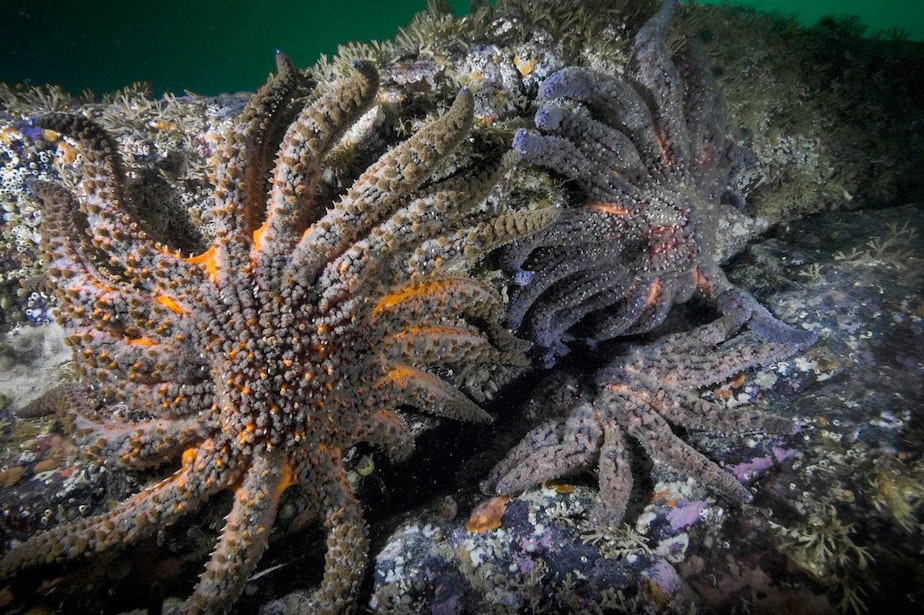San Juans’ sea stars start long crawl back from near-extinction

Twenty pint-sized predators—the first of their kind to be bred in captivity and released into the wild—are now crawling around the San Juan Islands.
The colorful sea creatures are called sunflower stars. The fastest of all sea stars, they are thought to be the most endangered as well.
A mysterious wasting disease killed an estimated 5 billion of them, or 90% of their global population, over the past decade, disrupting underwater ecosystems from Alaska to Baja California.
University of Washington researchers have been raising the many-legged bottom dwellers in seawater tanks at Friday Harbor Laboratories on San Juan Island since 2019.
In July and August, that effort produced its first real-world benefit for the troubled species. Divers lowered two plastic tubs with 10 animals each to an eelgrass meadow off the lab's dock at Friday Harbor on San Juan Island.
The animals, each between 1 and 3 years old and ranging in size from a cookie to a dinner plate, slithered out of the tubs on thousands of tube feet and into the surrounding kelp and eelgrass.
Sponsored

 1 min
Captive-bred sunflower stars crawl to freedom in San Juan Channel off Friday Harbor, Washington, in a time-lapse video on July 29, 2024.
1 min
Captive-bred sunflower stars crawl to freedom in San Juan Channel off Friday Harbor, Washington, in a time-lapse video on July 29, 2024.
“They were kind of crawling over each other to get out,” research scientist Jason Hodin said. “It was like they had never been out in the wild, but they couldn't wait to get out there and explore.”
Hodin’s lab had captured mature sunflower stars from the wild, mated them, and raised the offspring from microscopic larvae to small living stars.
“What we're releasing is stars that were born and bred entirely in captivity, and that has never been done before,” Hodin said. “We're the only lab that has raised these stars up in captivity.”
RELATED: Rare and resilient: Sunflower sea stars found on Oregon Coast
Sponsored
In February, Birch Aquarium in California, a state where sunflower star numbers have plummeted 99%, successfully spawned three stars, and several aquaria have started raising the invisibly small larvae.
They take about three years to become sexually mature adults and can live up to 65 years.
“These efforts are now finally getting off the ground. It's very exciting,” Hodin said.
Of course, a couple dozen sunflower stars are a drop in the ocean compared to the billions that melted away in one of the worst wildlife pandemics on record.

“Such a large number were impacted over such a large area that captive rearing probably isn’t realistic for restoring populations,” said Bellingham-based researcher Melissa Miner with University of California, Santa Cruz. “Raising them to sub-adult size takes a lot of time and resources.”
“That's not going to happen in our little lab in Friday Harbor, Washington,” Hodin said. “But we can show the way for how a larger-scale facility or a network of facilities in a place in like California could be raising sufficient numbers of stars for reintroduction.”
Hodin said a shorter-term goal could be to target local hotspots where an absence of sunflower stars has allowed their prey, sea urchins, to devour kelp beds unchecked, ruining a key habitat for many ocean creatures.
“Stars being introduced to a local area to do local environmental protection, that could actually be pretty effective,” Hodin said.
RELATED: 14 baby sea stars are tiny bundles of hope for their critically endangered species
Sponsored
“It’s a tool that’s good to have in the arsenal for preserving a species,” Miner said.
Researchers in Washington state and elsewhere continue to hunt for the causes of the wasting disease that has turned 20 species of sea stars to goo up and down the West Coast—and continues to do so.
“It’s still persisting at a low level, and it flares up in places,” Miner said.
RELATED: Signs of recovery after world’s worst underwater pandemic
A once-dominant predator of West Coast tide pools, the ochre or purple star, has started to recover from the die-off in much of its range.
Sponsored
Tidepool surveys in 2024 near Neah Bay have found a much smaller species, the six-rayed star, to be heavily infected.

“That’s pretty common that one species is more affected than others at any given time,” she said.
In 2020, biologists with the International Union for Conservation of Nature listed the sunflower star as “critically endangered,” the first sea star to gain that unfortunate status.
Neither the U.S. nor the Canadian government has given endangered species protections to the sunflower star.
Sponsored
In 2021, the nonprofit Center for Biological Diversity petitioned the National Marine Fisheries Service to list the sunflower star as an endangered species. The agency is expected to make its decision in 2025.
RELATED: Looking back and looking ahead: the 50-year anniversary of the Endangered Species Act
Without knowing the wasting disease’s causes, there’s a risk that introducing lab-raised animals to the wild could spread it.
Hodin said his lab and the Washington Department of Fish and Wildlife have agreed on a protocol to prevent any diseased animals from being released. The lab monitors its stars for early signs of disease, multiple times a day, for weeks before releasing them.
Sunflower stars hold their arms differently when they’re distressed.
“We call it wavy arm,” Hodin said.
Treating sick stars with iodine baths and cold water, the protocol developed at the Oregon Coast Aquarium, has helped bring several animals back to health.
Divers have been checking up daily on the freed animals, and Hodin's team is trying to train a computer to recognize photographs of each individual.
Fully grown stars—often almost the size of a garbage-can lid—can be easily distinguished from each other, Hodin says, similar to how whale researchers can identify individual orcas by the patterns on their backs.

While the newly released 1- and 2-year-old sunflower stars haven’t been named yet, the research team gave their wild parents names: everything from Van Gogh and Prince (because of his purple stripes) to Ursa Minor, Ophelia, and Clooney.
“This might be shocking to hear,” Hodin said. “They have personalities.”
Some stars are compliant and let themselves be picked up, while others stubbornly resist, clinging with their thousands of tiny tube feet to whatever surface their arms are draped over.
“We had long struggles where I would try to pick up Harriet,” Hodin said.
As the younger stars grew larger and needed more room, some of the wild stars, including Harriet, were released back to the spots where they had been captured a few years earlier.
“So long, and thanks for all the larvae, but you can go back to your home now,” Hodin said.





